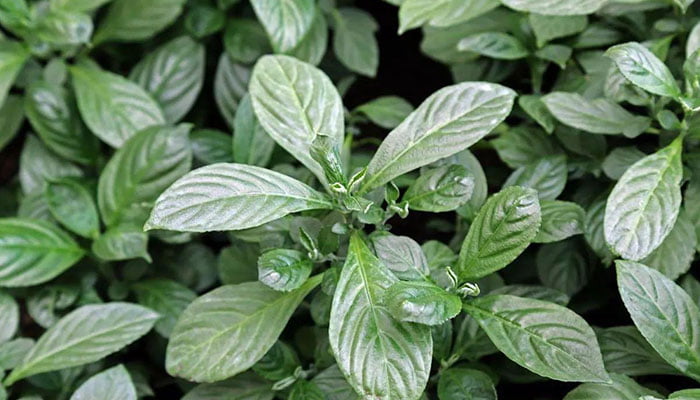What Is Da Qing Ye
Da Qing Ye also known as Folium Isatidis is the leaf of Isatis Indigotica, which is a biennial herb belonging to the family Cruciferae. It first appeared in <Mingyi Bie Lu> around 420-589 AD.
This plant is native to China and is now distributed in the Hebei, Jiangsu, Anhui, and Shaanxi provinces of China. Its roots can also be made into Chinese herbs, which is called Ban Lan Gen. Its leaves can be made into blue dyes, and its seeds can be refined into industrial oils.
Every summer and autumn, people gather the leaves of Isatis Indigotica, wash them with water, chop them, use them directly or dry them in the sun, and make them into Chinese herbal medicines.

Da Qing Ye contains indigotin, indirubin, A, 4(3H)-quinazolone, tryptanthrin, qingdanone, deoxyvasicinone, methyl pyropheophorbide a, ethyl pyropheophorbide a, octadecanoic acid, pyroglutamic acid, linoleic acid, linoleic acid-1-monoglyceride, salicylic acid, syringic acid, benzoic acid, anthranilic acid, isoscoparin, isovitexin, saponarin, β-sitosterol, γ-sitosterol, sucrose, amino acids, lignans and a small number of inorganic elements.
Generally, dark grayish-green and fragile Da Qing Ye with a light brown-yellow petiole is preferred.
According to <Compendium of Materia Medica>, the medicinal nature of Da Qing Ye is relatively cold, with a bitter taste. It has a certain therapeutic effect on the pathological changes of the heart and stomach meridians.
In Traditional Chinese Medicine, it is often used to clear heat and remove toxins, cool blood and resolve ecchymoses, treat influenza, upper respiratory tract infections, Japanese encephalitis, acute infectious hepatitis, acute dysentery, enteritis, Periodontitis, and cervicitis.
There are about 50 kinds of traditional Chinese medicine prescriptions containing Da Qing Ye, such as Xiao Yin Pian, Xiao Er Ganmao Keli, and Li Dan Pian.
Benefits
- Anti-inflammation, inhibiting mouse foot swelling induced by egg white.
- Inhibiting influenza A virus, Japanese encephalitis virus, mumps virus, herpes simplex virus, cytomegalovirus, and dengue virus.
- Reducing liver damage induced by CCL4 and protecting the liver.
- Inhibiting platelet aggregation caused by adiponectin and preventing atherosclerosis.
- Degrading endotoxin, reducing the pyrogenicity and lethality of endotoxin.
- Removing heat toxins, treating high fever, unconsciousness, and maculae caused by heat entering nutrient-blood.
- Relieving fever, headache, thirst, and sore throat in the early stage of warm diseases or wind-heat syndrome.
- Clearing excess-fire in heart and stomach, treating sore throat and mouth ulcers caused by the exuberance of heart and stomach fire.
- Treating fever, headache, epidemic parotitis, and pharyngitis caused by epidemic heat syndromes.
- Eliminating skin redness and swelling, treating sores, carbuncles, and erysipelas.
- Animal studies have found that it can significantly increase the secretion of bile in dogs.
- Its decoction can inhibit the isolated heart of toads. The larger the dose, the more obvious the inhibitory effect, and it can even cause cardiac arrest. In addition, its decoction can expand the blood vessels of the lower limbs of rats.
- Its water extract, alcohol extract, and decoction can inhibit Staphylococcus aureus, streptococcus A, streptococcus B, meningococcus, pneumococcus, catarrhalis, typhoid bacillus, Escherichia coli, diphtheria bacillus, dysentery Bacillus, Salmonella, Bacillus anthracis, Leptospira.
- Indirubin is an effective drug for the treatment of chronic myeloid leukemia. Both it and its derivatives can promote the apoptosis of tumor cells.
Combinations
- It can be used in combination with Shui Niu Jiao (Cornu Bubali), Xuan Shen (Radix Scrophulariae), Zhi Zi (Fructus Gardeniae), etc. to treat high fever, unconsciousness, macules caused by seasonal febrile diseases.
- It can be used in combination with Ge Gen (Kudzu Root), Lian Qiao (Fructus Forsythiae), etc. to alleviate fever, headache, thirst, sore throat in the early stage of warm diseases or wind-heat syndrome.
- It can be used in combination with Sheng Di Huang (Radix Rehmanniae), Da Huang (Radix et Rhizoma Rhei), Sheng Ma (Rhizoma Cimicifugae), etc. to sore throat, aphtha, and tongue sore caused by the exuberance of heart and stomach fire.
- It can be used in combination with Pu Gong Ying (Dandelion), Zi Hua Di Ding (Viola Yedoensis), Chong Lou (Rhizoma Paridis), etc. to eliminate skin redness and swelling, treat erysipelas.
- It can be used in combination with Ban Lan Gen (Radix Isatidis), Jin Qian Cao (Lysimachia), Da Huang (Radix et Rhizoma Rhei), etc. to treat male condyloma acuminatum.
- It can be used in combination with Ban Lan Gen (Radix Isatidis), Bai Hua She She Cao (Hedyotis Diffusa), etc. to treat abscesses of palm and plantar.
Side Effects
- It has been reported that cattle may have toxic reactions after eating large amounts of it, such as blood in the urine, decreased appetite, depression, dysuria, or blood in the stool.
- A small number of patients overdose it may cause abdominal pain and diarrhea.
- Large-dose and long-term toxicity experiments have found that it can cause liver sinusoidal dilation and congestion, liver cells generally atrophy and liver cells swell and deform.
Precautions and Warnings
- The dosage of Da Qing Ye should be controlled at 9-15g.
- When using fresh Da Qing Ye, the dosage should be controlled at 30-60g.
- It can be made into decoctions or mashed for external use.
- It should not be taken at the same time as vitamin C.
- People who are allergic to Da Qing Ye should not take it.
- Patients with deficiency-cold in the spleen and stomach should not take it.
- Pregnant women should not take it.
